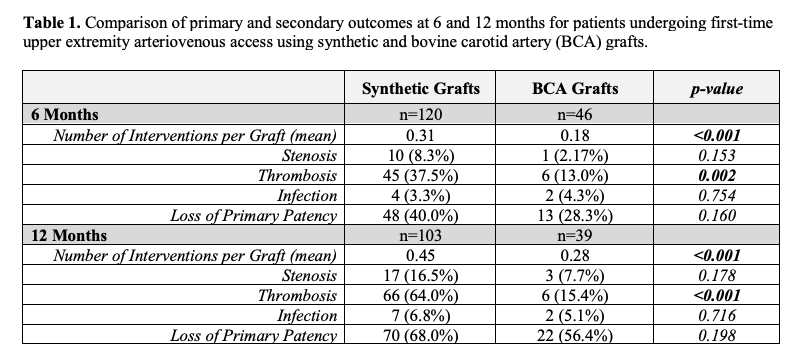Comparison of Non-Autologous Hemodialysis Grafts: Bovine Carotid Artery versus Synthetic
Richard A Meena, Mustafa A Khader, Maja Wichhart Donzo, Olamide Alabi
Emory University, Atlanta, GA
BACKGROUND: An arteriovenous fistula is considered the optimal option for first-time hemodialysis arteriovenous access (AVA). However, patients often present with poor caliber upper extremity veins. Therefore, comparing non-autologous graft conduit choice is essential to optimize therapeutic decision-making. We aimed to compare outcomes between bovine carotid artery (BCA) and synthetic grafts for first-time upper extremity AVA.
METHODS: We performed a retrospective review of first-time upper extremity AVA at four hospitals within a large, academic healthcare network between 2003 and 2022. The primary exposure variables were BCA and synthetic grafts (including immediate-use grafts). Demographics, comorbidities, and conduit type were obtained via chart review. Primary outcomes included stenosis and thrombosis rates at 6 and 12 months. Secondary outcomes included loss of primary patency and number of interventions per graft at 6 and 12 months. Chi-square and independent sample t-test analyses were used to compare categorical and continuous variables, respectively. Kaplan-Meier curves were constructed to compare patency.
RESULTS: Of the 296 non-autologous, first-time upper extremity AVA included in our study, 220 (74.3%) were synthetic, while 76 (25.7%) were BCA. There were no significant differences in age, birth sex, race, baseline comorbidities, or median follow-up times between the two cohorts. Synthetic and BCA grafts had similar rates of infection and stenoses requiring intervention at 6 months and 12 months (Table 1). Synthetic grafts thrombosed at a higher rate than BCA, both at 6 months (37.5% versus 13.0%, p=0.002) and at 12 months (64.0% versus 15.4%, p<0.001). Further, the mean number of interventions per graft was higher for the synthetic cohort at 6 months (0.31 versus 0.18, p<0.001) and at 12 months (0.45 versus 0.28, p<0.001). Loss of primary patency was not significantly different between the two cohorts at 6 or 12 months.
CONCLUSIONS: At 6 and 12 months, synthetic grafts had a higher mean number of interventions per graft and were more prone to thrombosis when compared to BCA hemodialysis grafts. A large-scale prospective study is necessary to elucidate whether BCA grafts still hold these advantages over synthetic grafts among patients requiring first-time upper extremity AVA. 
Back to 2023 Posters


